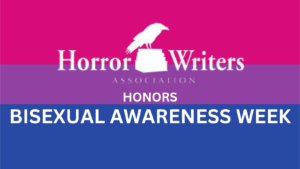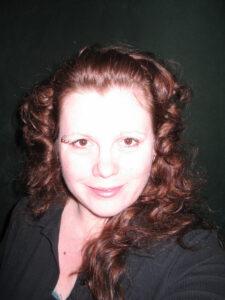Bisexual Awareness Week — B Stands for Bisexual by Angel Leigh McCoy

LGBTQ+ — B Stands for Bisexual
Our job as fiction writers requires us to step into the hearts, minds, and bodies of other people. For this reason, writers are some of the most empathic beings I know. We’re skilled at using our imaginations. We use that tool to choose the actions, thoughts, and feelings experienced by our characters.
The diversity of our characters and their stories can attract a broader audience to our writing, add stronger storytelling to our works, and—dare I say it—open our readers’ minds to empathy and compassion.
We learn to avoid stereotypes and clichés in our writing. We respect the integrity of our characters’ histories, profiles, linguistic quirks, and personalities. From the whole cloth, we create fully-formed humans who live, love, and make choices—both good and bad. The more these characters ring true, the greater the illusion we present to our readers—and the more our readers love us. Boom!
In the interest of giving you tools to add more flavor and authenticity to your work, I’d like to pull back the curtain a bit on bisexuality.
I’m going to ask you to step away from outdated binary models of interpersonal attraction and into a spectrum of possibilities. Sound scary? Sound hippy? It’s not. You’re in absolutely no danger. I promise.
DISCLAIMER
I know I don’t need to say it, but I’m going to anyway. Every person on this planet is unique. No one is the same in terms of experience, DNA, brain chemistry, upbringing, education, desires, or dislikes. Therefore, most of what I will say in the following paragraphs will be untrue for a portion of people. If I sound too generic—or heaven forbid, noncommittal—in my statements, it’s in an effort to avoid reinforcing or even creating stereotypes in your mind. I know this is probably not new to many of you. It never hurts to have a refresher, though. Amiright?
WHAT IS BISEXUALITY?
Merriam-Webster has several definitions, but as the author of this article, I’m going to choose my favorite to share:
Bisexual (adjective) – of, relating to, or characterized by sexual or romantic attraction to people of one’s own gender identity and of other gender identities.
Exactly. It’s no more complicated than that. You meet someone you think is funny, sweet, and sexy…and you fall in love. The characteristics that draw me to someone may have little or nothing to do with their gender identity. For you, your date’s gender may need to conform to social norms. You do you. That’s the whole point. Freedom to love who you love.
WHAT ISN’T BISEXUALITY?
What that definition doesn’t include are:
- promiscuity
- sex addiction
- willingness to ménage-à-trois
- sexual predation
- disloyalty
- dishonesty
- an inability to be monogamous, etc.
These are all stereotypes that some people apply to bisexuals, often without realizing it. Sure, some bisexuals have unhealthy characteristics, just like any human. But none of them go hand-in-hand with being bisexual. None are naturally caused by bisexuality.
WHAT DOES BISEXUALITY LOOK LIKE—SOMETIMES?
Sometimes, bisexuality looks like these people:
- The man who marries a woman, loves her, has children with her, believes he’s straight, then finds himself alone through divorce or death, and he meets a man he can’t stop thinking about.
- The woman who spends her college years with multiple lovers of different gender identities, falls in love with someone, and settles down to a lifelong monogamous relationship.
- The man who sees no reason to choose between the people he loves.
- The woman who, influenced by her upbringing, believes it’s shameful to love another woman. She gives that up and marries a man she loves and finds equally attractive. They live happily ever after.
- The man who remains in the closet because it’s easier than having to explain his bisexuality.
- The woman and man who are married and monogamous in the public eye. In private, they have an open relationship. One or both take lovers of other gender identities.
Such rich stories, all from my imagination, and an infinite number of other options exist–some complex, some simple.
WHAT DOES BISEXUALITY LOOK LIKE—IN FICTION?
I want to point out a few existing characters in works of Horror who are examples of bisexual characters.
- Carmilla (Carmilla by Joseph Sheridan Le Fanu): She’s a vampire. Enough said.
- Hannibal Lecter (Silence of the Lambs by Thomas Harris): Obviously.
- The Countess (American Horror Story: Hotel, tv series): played by Lady Gaga.
- Dorian Gray (Penny Dreadful, tv series): modeled on a classic character
- Nell Vance (The Haunting of Hill House by Shirley Jackson): The hints may be subtle, but they’re there.
- Car Michael (Lost Souls by Poppy Z. Brite): another vampire
- The Baroness (Gothika, film): played by Penelope Cruz
- Louis (Interview with the Vampire by Anne Rice): Vampire, for the win!
- Willow (Buffy the Vampire Slayer, tv series): a story of discovery and love
I’ve read that some readers speculate that Victor Frankenstein and Pennywise are bi, based on the symbolism and metaphor in those works.
That was fun, so here are more taken from non-horror TV, movies, and books. I think you’ll recognize them.
- River Song from Doctor Who, tv series
- Darryl Whitefeather from Crazy Ex-Girlfriend, tv series
- Eleanor Shellstrop from The Good Place, tv series
- Oberyn Martell from A Song of Ice and Fire by George R.R. Martin
- Clarke Griffin from The 100, tv series
- Captain Jack Harkness from Doctor Who and Torchwood, tv series
- Rosa Diaz from Brooklyn Nine-Nine, tv series
HUMANS WILL BE HUMANS
When you’re writing bisexual characters, remember that their sexuality is only part of who they are. To avoid tokenism and caricature, add depth and complexity to your characters’ lives, personalities, hopes, fears, and experiences. Imagine a more fluid interpretation of relationships. Remember that bisexuals fall as deeply in love as anyone. They’re equally as susceptible to becoming obsessed, to enacting a crime of passion, and to having their hearts broken. They don’t limit their love potential to one gender. They are turned on by other colors of the rainbow.
CONCLUSION
When I was young, I didn’t know that bisexuality was an option. I was raised to see the world in blue and pink. Nothing in between. I was taught that I was firmly in the Blue camp and any time I colored outside those lines, I was “just” experimenting or rebelling.
In my mid-twenties, I fell madly in love with a woman. Even then, I didn’t come out to anyone. I didn’t want to freak anyone out with the truth, and more so, I didn’t want to deal with the awkwardness that might follow. So, I hid. It’s easy to do when you’re bi. I chose the path of least resistance and denied the complexity of my heart. I gave up my chance with that woman.
In our society, the veil is finally being lifted off of just how special and unique we all are. Personally, I’m hoping for a pansexual future for our global society. Love is love. Consent is everything. We humans have so much more value than what our genitalia bring to the table. We still cling to labels, many of which are outdated and myopic. I can’t wait to see them discarded.
I want to thank the HWA for inviting me to share. I hope at least one person finds this useful. If you did, please feel free to let me know.
I’d like to wish you well on your writing journey. As this year’s diversity interviews appear on the site, read them knowing that they are full of fodder for character ideas and can serve as accelerators for the expansion of your imagination and your storytelling. Peace.
RESOURCES
If you want to research bisexuality, these websites can help you.
- Bi.org: an online community that features articles, personal stories, and resources related to coming out, activism, and relationship health.
- BinetUSA.org: an organization that advocates for bisexual rights and provides resources, such as lists of local support groups.
- Biresource.org: a nonprofit organization (Bisexual Resource Center) that supports bisexuals. They provide FAQs, coming-out guides, and articles on other relevant topics.
- Bisexual.org: a blog and resource site that covers topics such as bisexuality basics, identity, relationships, and activism.
- BisexualResearch.org: an academic/science institute that promotes research on bisexuality and supports bisexual scholarship. They share research papers, publications, and other resources related to bisexuality.
- TheTrevorProject.org: although focused on youth, this group offers resources and support for all ages. They maintain a 24/7 helpline for crisis intervention.
IMPORTANT: If you have specific questions about, concerns about, or challenges with your own bisexuality, I encourage you to reach out to a qualified professional or local LGBTQ+ organization to receive guidance and support.
Angel Leigh McCoy – Bio (she/her)

I also identify as an author. I write the Wyrdwood series of paranormal suspense and mystery novels. You might consider checking out The Catsitter’s Conundrum about a middle-aged catsitter who is also an amateur detective.
My Horror collection is called Dark Was the Night. My writers’ group, WilyWriters.net, is my fuel, my comfort, and my alcohol. They keep me steady, giddy, and ready to rock. We published a series of anthologies together: Wily Writers Presents Tales of Dread (ed. Lisa Morton), Tales of Nightmares (ed. Loren Rhoads), Tales of Foreboding (ed. E.S. Magill and Bill Bodden), and Tales of Evil (ed. Angel Leigh McCoy [me!] and Alison J. McKenzie). Come find out more at WilyWriters.net and AngelMcCoy.com. Be sure to say hey!



